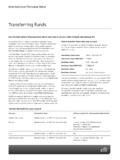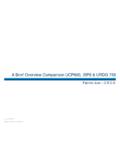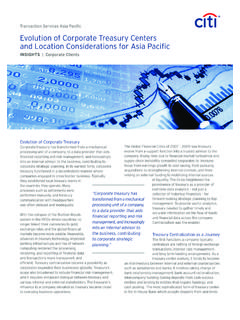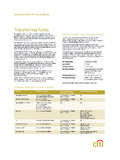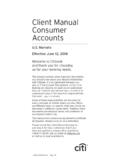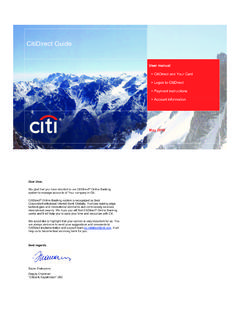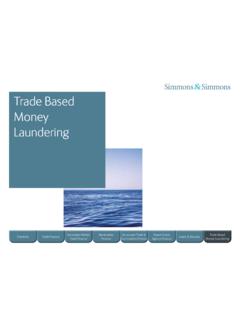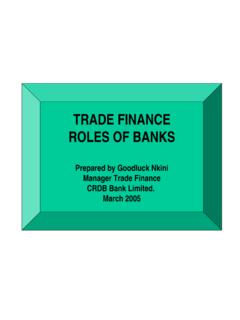Transcription of Optimizing Liquidity Through Supply Chain Finance - Citibank
1 Optimizing Liquidity Through Supply Chain Finance For Corporate ClientsGLOBAL TRANSACTION SERVICESINduSTRy INSIGhTIn a world where headline news events are often out of our control, one thing that can be managed is the delivery of Liquidity to the Supply Chain Through effective Supply Chain Finance . Supply Chain Finance programs provide consistent and cost-effective sources of Liquidity to suppliers, can be drawn upon at any time and preserve availability of credit lines. Delivering a reliable source of Liquidity in times of uncertainty is prudent for any financial of AgeSupplier financing has developed significantly since the credit crunch began in late 2008.
2 Previously seen as a source of financing for small and medium-sized enterprises (SMEs) or for companies in distress, an increasing number of companies particularly large multinationals with strong credit ratings have recognized the potential to help unlock Liquidity and increase the power of the financial Supply Chain . Many view Supply Chain financing as a stopgap technique during troubled times. However, as markets have begun to ease globally, its value remains undiminished and will likely become even greater in the coming years. With more conservative credit models and more stringent banking regulations, credit will not be as cheap or accessible as in pre-crisis days.
3 Optimizing Liquidity remains key to funding future investments. Benefits Beyond Working Capital ImprovementsHistorically, many companies used Supply Chain financing as a tool to improve working capital, an advantage closely held by the sponsor company, or the buyer. While increasing days payable continues to be a primary benefit, buyers today are finding that the injection of Liquidity is a significant benefit, freeing up credit lines for investment and growth. Often, this investment results in increased productivity, further reducing Pacific Improving working capital is anything but staid it s central to delivering bottom-line results in any business environment.
4 During 2008 and 2009, companies with Supply Chain Finance structures in place were able to weather the financial crisis more comfortably than those without. Why? Across the globe, SMEs were starved of working capital and access to credit was simply shut off. However, corporates with programs in place were able to leverage their strong credit standing to deliver low cost Liquidity to their suppliers. Indeed, the stability of the Supply Chain often depended on this source of weakness of the US dollar is another trend affecting working capital. For example, trade flows into Asia from large North American retailers are mostly in US dollars, which is devaluing against other Asian currencies.
5 Many of these Asian suppliers are highly developed manufacturers with significant local currency Supply chains of their own. The ability to Finance receivables well ahead of the payment term (often 60 to 90 days) provides sophisticated suppliers with an effective hedging tool on their US dollar receivable Partnerships in Global and Emerging Markets Major multinationals want a partner that can deliver a consistent service globally. Companies such as Kimberly Clark and Stanley Black and Decker, two companies at the forefront of treasury management and Treasury & Risk magazine s Alexander Hamilton award recipients, (an annual award to top companies and multinationals for excellence and innovation in treasury management ) demand delivery of a consistent program globally.
6 Multinational companies not only require consistency in technology, but also a consistent approach to bringing suppliers on board, deft program management capabilities and local people on the ground. This consistency delivers significant cost reductions as the need for training, technology re-engineering and legal work is minimized. Regional nuances overseeing program implementation and getting suppliers on board are very real. In the US, contact with suppliers can generally be conducted by telephone. However, in many cultures Asia a prime example corporates want to meet their trade partners and do business face to face.
7 The extent in which a partner bank has local resources and is attuned to local business practice is therefore crucial to the success of a Supply Chain Finance addition, more companies from emerging markets are going global and looking to expand their local Supply Chain Finance programs across the new regions in which they are doing business. Like established multinationals, these companies are looking for a consistent approach when entering Asia, Europe, the Middle East, Africa or Latin America. It is vital that their trade bank is investing time and resources in nurturing relationships with corporates in these growing emerging markets and will support their Supply Chain Finance programs Through the same methodology as they have done with the biggest multinationals.
8 Although Asia is a region in name, attention to country-specific regulations is vital. Companies are looking for a global banking partner that has the ability to deliver Through experienced local teams in individual Asian countries and enables them to leverage programs that they may have implemented in other regions. In addition, more discussions are taking place with emerging market corporates looking for domestic programs. China, South Korea and Australia are markets where there is a particularly strong growing interest in domestic programs. Many view Supply Chain Finance as a stopgap financing technique during troubled times.
9 However, as markets have begun to ease globally, the value of Supply Chain Finance remains undiminished and will likely be even greater in the coming years. In the Trenches: ComplianceFor many companies it is important to maintain trade payables treatment and keep Supply Chain Finance transactions off balance sheet. They need a trade bank that has worked across its own network of accountants, structured Finance experts and accounting policy specialists to deliver structures that maintain trade payable , within Asia there are a good deal of cross-border flows and cross-border financing. Whether doing business in Asia or any other part of the world, it is critical to understand the regulatory implications, including tax, financing and marketing, to name just a few.
10 In conducting business both globally and locally, understanding what corporates are allowed and not allowed to do, as well as the ramifications of certain actions, is certain markets, cross-border financing is cheaper than in-country financing. For example, US dollar financing onshore in China is more expensive than offshore in China. An experienced banking partner with the breadth of regulatory, trade Finance and transaction banking expertise at the local country level can help structure a deal whereby the company gets optimal benefits from such discrepancies in funding and ensures a transaction is conducted within local regulatory guidelines.

